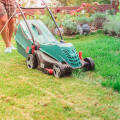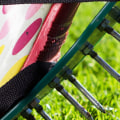Follow these spring lawn care tips to make sure your garden is lush and green this summer. Raking is the first thing you need to do to prepare your lawn for new growth. You may still have some fallen leaves on the ground, however, raking in early spring is mostly done to remove straw. Rake deeply and thoroughly to help break up any grass debris from the previous growing season.
Before adding soil amendments, send a soil sample to your local cooperative extension office to determine soil acidity. The Cooperative Extension Office is a free educational resource that offers science-based assistance in agriculture, horticulture and other areas of expertise. All you have to do is call, visit their website, or visit your local extension office, and they can advise you on how much lime per square foot you will need. You will need a fertilizer droplet spreader to apply lime.
A lawn plagued by bare patches due to dog stains, heavy traffic, or negligence may need an application of grass seed to fill those patches. Overseeding is the process of sowing seeds on existing turf. Apply a slow release nitrogen fertilizer (starter fertilizer) when you are overseeding. Keep the new seed moist until it has sprouted and is actively growing.
Five weeks after the herb germinates and sprouts, you can start a normal fertilization routine with quick-release nitrogen fertilizer. It is possible to apply seeds only to visible bare patches, but it is also quite common to oversow the entire lawn to ensure that the lawn remains thick and healthy. This can also be a way to introduce new varieties of grass seeds to your lawn. For example, if you've recently lost some shade trees, overplanting with a sunny grass mix can help your formerly shaded lawn continue to thrive.
Autumn is the preferred time for oversowing, but if your lawn urgently needs help, you can do it in spring. Get ready to deal with the crab grass that grows and feeds on fertilizer. The lawn can be fertilized organically by covering it with compost or using a mulch mower to cut grass clippings and turn them into a nutrient source of nitrogen. But, for those who prefer the fast-acting effects of a chemical fertilizer, the company Scotts-Miracle-Gro offers a widely accepted program for fertilizing lawns that includes a spring feeding.
However, many experts recommend a lighter feeding in spring and a more abundant one in late autumn for cold-season grasses. Excess fertilizer in spring can lead to disease and weed problems, and if you fertilize in late fall, your lawn still has fertilizers to feed in spring. A variety of weed products and feed are available that aim to handle fertilization and weed prevention tasks in a single application. However, many lawn care experts do not recommend them, since the ideal time for herbicide application is different from fertilizers.
Simultaneous application of high levels of nitrogen is usually the worst thing you can do if you're trying to prevent or eliminate weeds. It is much better to apply a pure herbicide at the recommended times for crab grass and other weeds, and then separately apply a nitrogen lawn fertilizer at the recommended feeding time. And keep in mind that most pre-emergent herbicides also work against turf seeds. Overseeding is not very effective if a traditional pre-emergent herbicide is also applied.
In years when you are placing a pre-emergent herbicide, wait until early fall to sow with grass seed. Replace oil, air filter and spark plug. Once you're done high-fiving, clean the top and running gear, removing dirt and grass clippings; just be sure to disconnect the spark plug wire before working around the cutter blade. Don't turn a gas cutter upside down to clean the bottom; just lift one side and remove dry grass with a brush.
If the dry grass has hardened, loosen it with a hand spatula or spatula. A dull blade makes mowing the lawn more difficult. Sharpen that blade and replace it if it has large notches or notches. It is a good idea to have an additional blade handy to always cut with a sharp edge.
Now fill your lawnmower with gasoline or charge the battery, because, well, energy. Apply spring fertilizer about three weeks after the lawn starts to green or after the first two or three cuttings. Apply too early and you risk feeding weeds and creating fertilizer runoff. If you have problems with the screen reader on this website, please call 1-800-430-3376 or text 38698 (standard carrier rates apply to messages.
Follow These 10 Spring Lawn Care Tips to Keep Your Lawn Thriving Year-Round. Or, if you don't have time to commit to fertilizing, aerating, and more, you may want to consider hiring a professional lawn care company to take care of this long to-do list for you. We recommend TruGreen for its comprehensive packages and wide availability. Below you'll find This Old House's top tips for springtime grooming your lawn.
Some of these tips may not work together: Overseeding and applying herbicides at the same time can be counterproductive, for example, but we've summarized them all so you can choose the tips that best suit your lawn. Next, it's all about wiping a clean slate. If you thought raking was only for autumn, something else awaits you. You will need to rake fallen leaves, general debris and any grass that may have died during the winter.
Be sure to rake when the soil is dry. If it is too wet, you can start healthy grass. You can use a special rake to remove the straw if it is too dense for your normal rake. Early spring is the ideal time to remove cold-season grass, while you should wait until late spring if you are caring for a warm-season lawn.
If the soil on your lawn has compacted, it's time to separate it and give it space to breathe. Soil can be compacted by heavy foot traffic, making it too dense for water, air, and nutrients to reach grass roots. In general, it's best to air in the fall, but when the time comes, you may have to do it in spring. If the soil has a lot of clay, it is more likely to compact.
When aerating the lawn, thousands of small holes are introduced into the soil, allowing water, air and nutrients to enter the grass roots. You have multiple options when it comes to aeration machines. Spike aerators use solid spikes to pierce the ground. Plug aerators remove a plug or core from turf and soil.
One advantage of plug aerators: you can let the core break down on top of the grass, giving it more nutrients. During this season, try not to take shortcuts instead, climb high. Most lawns give their best at a grass height of 3 to 4 inches, so they cut only 1/3 of the length of the leaves. You need to adjust the mower to cut at the highest setting for your lawn type.
If winter has left your lawn with bare areas, be prepared to oversow. Try to wait until autumn, as the new seeds will not have to compete with so many weeds. Overplanting can thicken the lawn and return it to its former lush splendor. The lawn builder you choose will have a mix of seeds and fertilizers.
The different types are suitable for cold season grass and warm season grass, so be sure to check the specific type when buying your mix. Use a manual spreader to distribute the seed. After overseeding, it is essential to nourish the newly sown turf for the first few weeks. Apply a slow-release fertilizer to help it grow strong and healthy.
It's OK to be a parent of a helicopter plant, watering the area every day for the first two weeks. Weed control in spring requires herbicides before and after emergence. That is, if they are not oversown. Overseeding and the application of pre-emergent herbicides conflict with each other, as the herbicide will stop the germination of new turf seeds.
If you decide not to oversow, put pre-emergent herbicides on the offensive, preventing weeds from emerging in the future. Like overseeding, do not fertilize the lawn if you have applied herbicides. If you haven't, slow-release, nitrogen-rich fertilizers are your lawn's best friends. A high-quality fertilizer will nourish the lawn and help protect it from drought and heat.
Spring raking removes autumn leaves and grass leaves that did not survive the winter. If left alone, these dead blades add to the straw layer of your lawn. Raking also loosens matted grass clumps caused by snow mold, which can suffocate. Use a spring-loaded tooth rake with a strong upward pull to remove dead grass.
Rake when the soil is not soft and muddy, or you risk pulling out healthy grass crowns. Fill bare or thin areas of grass by overseeding. Late spring is the best time to overplant warm-season grass. Autumn is the ideal time for cold-season lawns, but in colder regions, spot sowing in small areas in spring yields good results.
When you are overseeding, apply a slow release nitrogen fertilizer. Five weeks after overseeding, apply a quick-release nitrogen feed. In early spring, use a combination of fertilizer, which feeds the lawn, and before the emergence, a herbicide used to prevent crab grass. Then, six to eight weeks later, reapply both products, along with a broadleaf herbicide.
He points out that many lawn care brands offer a combination of pre-emergent herbicide and herbicide in a single application, which will reduce their cost and the time it takes to apply them. Dead grass and grass clippings accumulate and turn into straw, which not only prevents germination of new grass seeds, but also promotes fungal growth and pest infestation. Throw the grass by giving it a good turn, using a lawn rake with rigid spikes or a special rake to remove the straw (see on Amazon). In high-traffic areas, the soil under the grass is gradually compacted and is inhospitable to grass roots.
Here, with a specialized tool (see on Amazon), stoppers the size of a wine cork are extracted from the surface of the lawn, allowing the roots to spread and allowing air, nutrients and moisture to penetrate the soil. Unless your lawn is heavily overgrown, it's best to apply chemical herbicides by spraying weeds rather than overspraying the entire lawn. A lawn aerator creates openings in the lawn that allow water and air to penetrate the ground and reach the bases. However, lawn care experts now believe that this causes more harm than good, as it breaks the roots of new lawn plants.
With all lawn fertilizers, follow the label instructions carefully for best results and do not apply additional fertilizers if you have recently applied a weed and feed product such as one of the above. Whether you're just starting out, servicing or troubleshooting, you'll find tips and answers for all your lawn care needs here. Once they take care of the lawn, border the beds, trim the dead branches of the bushes and replace the mulch. Lawn weeds (especially crabgrass) are the first seeds to germinate in the spring, and aerating the lawn stirs them up and gives them an ideal home.
In general, lawns need an inch of water per week, either from rain or from a spring lawn care routine with a garden hose, sprinkler or watering system. . .






